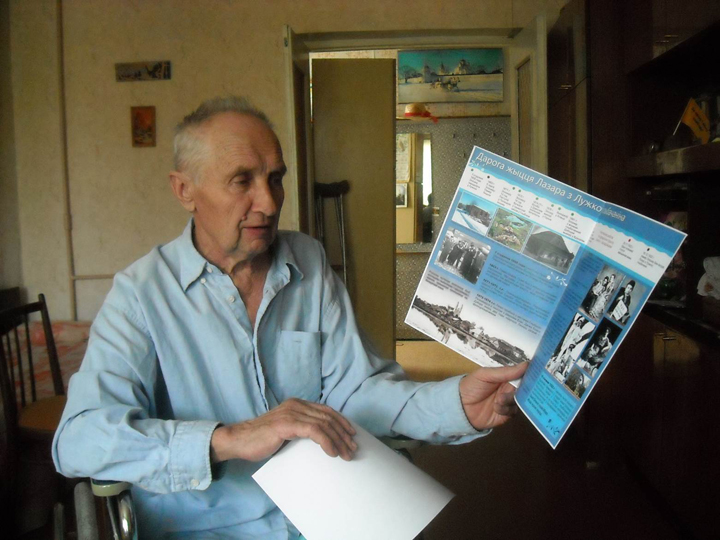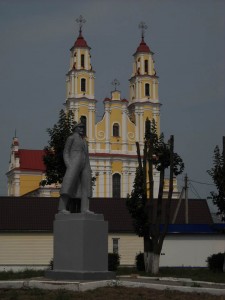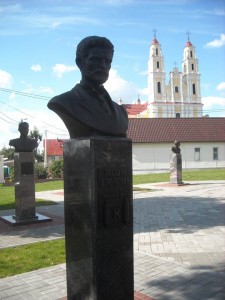
In September 2012, the town of Glubokoe [Belorussian: Hlybokae], in the north of Belarus, staged the annual Day of Literary Production and Printing. This official festival, organized in a different town every year, brings with it both prestige for the organizing municipality and special funding from the Ministry of Culture. The 2012 festival in Glubokoe reverberated not only locally, but also internationally. On the initiative of the local executive committee, the statue of Lenin was removed from the central square of the town and replaced with an interethnic "Walk of Fame," featuring busts of eight illustrious citizens of Glubokoe, including Józef Korsak (1590-1643), Polish governor of Glubokoe, Vaclau Lastouski (1883- 1938), historian and prime minister of the Belarussian People's Republic murdered by the Bolsheviks, as well as the father of modern Hebrew, Eliezer Ben-Yehudah (1858-1922).

The disappearance of the statue of Lenin, which on the occasion was removed "for conservation," is as telling as the choice of the distinguished men who took his place: a veteran of the Polish campaign against Moscow, a Belarussian nationalist, and a Zionist. The Glubokoe "Walk of Fame" not only symbolically rehabilitated the hitherto forgotten and "politically incorrect" protagonists of Belorussian history, but it also replaced the Soviet narrative of Communist unity with a vision of multiculturalism and ethnic diversity.
Projects that include Jews in the narrative of Belorussian history have also taken place on the initiative of Jewish institutions. The Jewish Museum in Minsk, for example, has in the last few years prepared a number of exhibitions and publications about Jews in the Belorussian antifascist resistance units. The anti-Lukashenko opposition has made similar gestures. The Belarus Free Theatre Publishing House, associated with the internationally renowned underground theatre company of the same name, published in 2009 One of Us, a biographical dictionary of prominent Belorussians. Out of twenty-six entries, ten are biographies of Jews, including Isaac Asimov, Marc Chagall, Kirk Douglas, Shimon Peres, Menachem Begin, and Eliezer Ben-Yehudah. The dictionary likewise lists a number of ethnic Poles, such as the heroine of the 1830 anti-Russian uprising, Emilia Plater, or the geologist Ignacy Domeyko. In the introduction the editors state their intention to establish a Belorussian national pantheon. By listing famous artists, writers, politicians, and scientists who came from Belarus, they hope to foster national pride and articulate a political message. "A country that has given the world so many geniuses, can and indeed should transform into a civilized, modern and sensible state." The multiethnic heritage is thus interpreted as a legacy of modernization and enlightenment that should inspire political change in Belarus.

The tradition of multilingualism and the linguistic diversity of Belorussian cultural and intellectual life before the Second World War today inspires both the activists dedicated to preserving Jewish heritage in Belarus and the anti-Lukashenko oppositionists, who resent the dominance of Russian in the public domain. Although the grassroots projects commemorating the Jewish past devote certain attention to Jewish languages, Jewish memory projects in Belarus have the revival of Belorussian language high on the agenda.
The grassroots projects devoted to Jewish heritage in places like Glubokoe reveal a wider interface between the new interest in the Jewish past and the highly politicized Belorussian national identity project. Public historians championing the importance of Jewish history in Belarus today not only frame Jewish history as an integral part of the Belorussian past, but also define Belorussianness itself via the federalist, multiethnic and multireligious heritage of the Great Duchy of Lithuania. This vision resonates with the anti-Lukashenko opposition which places Belarus in the realm of European cultural influence and cherishes the myth of the harmonious coexistence of various ethnic groups within the Polish- Lithuanian Commonwealth. Paradoxically enough, the narrative of Belarus's multiethnic heritage also strikes a chord with the official authorities who see the foundational myth of Belarus in the Belarussian Soviet Socialist Republic and gesture towards its early ideals of ethnic equality.
The current initiative to create a central Holocaust memorial space in Trostenets, just outside of Minsk, exemplifies the attempt of the Belorussian authorities to acknowledge the singularity of the Jewish suffering in the Second World War. The high profile of this project, realized with significant financial support from Germany and Austria, suggests that commemorating Jews in today's Belarus has important implications for the country's international relations and its image abroad. As the head of the Minsk municipal administration, Sergej Chilman, recently put it, "[the Trostenets monument] has a great meaning for Belarus's cooperation with Germany and Austria and the development of friendly relations between our states." The commemoration initiative in Trostenets, supported personally by the German president, Joachim Gauck, has a chance of becoming a flagship memorial project, which can help the Lukashenko regime to present itself as pursuing progressive memory politics and being open for international cooperation.
It remains to be seen if the small grassroots initiatives and the foreign-funded projects can inspire Belorussians to fill in the gaps in their historiography concerning the dark chapters of Belorussian-Jewish relations and help them address the problems of contemporary Belorussian Jews. Even though the authorities have undertaken some steps to counteract anti-Semitism, prosecuting neo-Nazis and closing down an anti-Semitic publishing house, there is no state support for Jewish culture and education and the burning question of the restitution of Jewish real estate has not yet been addressed. If Ben- Yehudah is to be the patron of this Belorussian change, let us hope that starting small can be the harbinger of bigger things to come.

